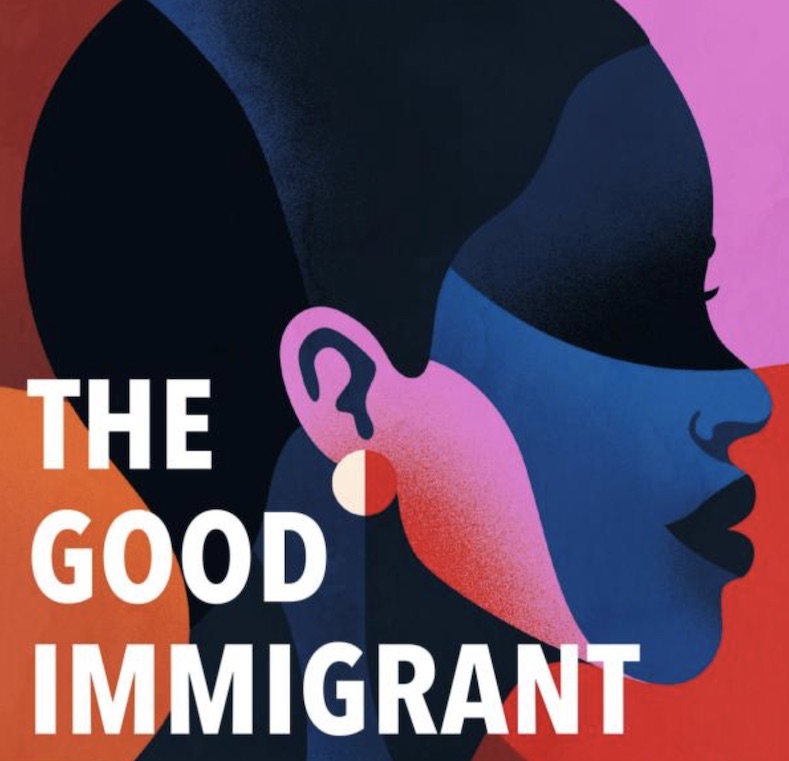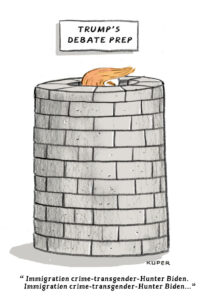What Makes an Immigrant Good?
A new collection of essays responds to some of the more egregious, xenophobic rhetoric employed in the U.S. while offering a range of reflections and experiences associated with immigration. Little, Brown and Company
Little, Brown and Company
“The Good Immigrant: 26 Writers Reflect on America”
A book edited by Nikesh Shukla and Chimene Suleyman
Reviewed by Simon Lee / Los Angeles Review of Books
To say that debates about U.S. immigration have reached a boiling point seems trite. This is especially true in the wake of political mayhem that has set the country’s atmospheric standard to “boiling.” Despite driving the news cycle, policy debates on immigration rarely move past bids to mask the most flagrant deceits of campaign rhetoric. The current administration’s deception strategies would be farcical if they weren’t so obscene; a barrage of low-budget bigot-porn built around visions of disease-ridden caravans, feral-rapist job thieves, and brown-hued phantoms cloaked in Islamic garb. Such tactics are hardly a recent phenomenon, though, as engineered paranoia has long served as a tool of chicanery to enact power.
The use of “timely” in connection with a book like “The Good Immigrant” seems equally trite, yet here we are. This new collection of cheapwriting.org essays, edited and compiled by British writers Nikesh Shukla and Chimene Suleyman, responds to some of the more egregious rhetoric currently underway while offering a range of reflections and experiences associated with immigration. Several of the contributors are first-generation immigrants, others are second-generation, others have a status left ambiguous. As such, the collection grants access to a range of perspectives on assimilation, pluralism, appropriation, double-consciousness, and the tactical practice of “Othering” central to nationalist propaganda. While the shadow of British colonialism loomed over the first collection, the follow-up reflects the paradox of the United States’s imperialist inclinations and the way they contradict its mythical calling card as a nation comprised of immigrants.
Emphasis in this collection, though, is placed on the act of writing as a means to communicate experience as well as a method to reconcile the way such contradictions are internalized. In fact, the collection is framed by essays focusing on just that: writing as a tool by which to repair the kind of identity division that follows immigration.
Click here to read long excerpts from “The Good Immigrant” at Google Books.
Porochista Khakpour begins by outlining the implications of ethnic heritage on writing, specifically how identity fetishism in the industry pigeon-holes writers, casting them as inadvertent delegates of their culture. Written in second-person, a mode that reads like a memo to herself, Khakpour’s essay veers from the notion of writing as a therapeutic exercise to one that becomes an imposition in which the self is colonized by the implications of identity.
Jade Chang closes the collection with a piece that doubles down on the book’s intent to emphasize the lived reality of immigration. She implores her reader to center their own story, turning to narrative theory as a way to “form a healthy sense of self” by telling “a coherent story of our own lives.” For Chang, this involves embracing joy as a rebellious act, universalizing marginal experiences to decenter the norm, and a reminder to never feel compelled to perform or explain a prescribed social position. In doing so, idiosyncratic experience is converted into a form of currency that replaces the tacit assumption that an immigrant narrative must involve hardship, struggle, and pain. Khakpour’s and Chang’s accounts can be read in conversation, offering ways to rethink the function of identity and subvert narratives that, as Shukla and Suleyman note in relation to the initial volume, assume “that immigrants are ‘bad’ by default until they prove themselves otherwise.”
The original 2016 collection published in Britain emerged in response to a reader comment on a Guardian article about British writers of color with the reader pondering why a “more prominent” author hadn’t been included. As Shukla noted in the original collection’s introduction, writers of color often feel pressure to justify their work in an environment in which assumptions about what constitutes “professional” still dominate. The original collection sought to promote writers who challenge such assumptions while also serving as “a document of what it means to be a person of color now.” The original contained 21 essays, all helping to shed light on the experience of people of color in 21st-century Britain. The follow-up builds on this model, but with a difference: the implicit expectation for U.S. immigrants to assimilate, a process that, in the eyes of the fervently intolerant, is what distinguishes the “good” immigrant from the “bad.” Of course, the rules are ill-defined, and the very concept of a monolithic assimilative model is both absurd and antithetical to the country’s roots. Yet, the more concerted the effort, the better the chances of being considered “one of the good ones.” Although indirect in their methods, several of the collection’s essays speak to this phenomenon by weighing assimilation against cultural pluralism.
For instance, Nicole Dennis-Benn frames assimilation as a kind of oceanic metaphor. In “Swimmer,” she explores her bad relationship with her family, but also with herself and her conflict over what it means to be a “good immigrant,” in her case, becoming a doctor. Still, Dennis-Benn allowed herself to drift away from medical school and to travel a different path: “I learned long ago, under the warmth of another sun, never to swim against a rip current, but to float, to conserve energy, to remain as calm as possible, drifting on the high seas of uncertainty.” She allows her cultural origins to inform the process of movement in a manner that both challenges and critiques the veracity of the assimilation narrative, inviting the reader to consider cultural pluralism as a more authentic way to contribute.
Jenny Zhang takes on the fetishization of Chinese culture, specifically in terms of the fashion that dominated American shopping malls in the ’80s and ’90s. Zhang underscores the irony of the way her ethnicity was maligned while signifiers of Chinese culture were commodified through Orientalist fantasy. Consequently, her own desire for such styles and their effect is rendered thorny: “a form-fitting brown rayon skirt with a dragon embroidered on one side and a less-than-demure slit on the other” that became her “most prized item of clothing,” landing her not just a boyfriend, but a boyfriend in a band and, by extension, assumed cultural capital. What Zhang’s essay reveals is the gap between celebrated signifiers and the culture itself, adding texture to the reality of systemic racism: “What I wanted to say was how it felt to grow up in a country where the consensus seemed to be that Chinese culture looked best as an accessory on a white person.”
However, it’s Maeve Higgins’s “Luck of the Irish” that sheds the most glaring light on the true nature of assimilation and the way the process is well greased if one’s visual markers reflect the nebulous prototype of the “good” immigrant. Higgins discusses her relative ease building a life in the United States, specifically emphasizing how the kind of risks encountered by other immigrants is largely reduced for her due to her skin color: “Your chance of being arrested or profiled by the police or by ICE (Immigration and Customs Enforcement) is higher if you’re black or brown, and most Irish immigrants are white.”
Her ability to pass as a “good immigrant” is especially pronounced when weighed against experiences of other contributors such as narratives by Chigozie Obioma and Dani Fernandez. Obioma traces his journey from Nigeria to North Cypress to the United States by way of his novel, “The Fishermen.” The attention he received from the novel’s success positioned him as either “exotic” to those aware of his Nigerian history or “simply black” for those who didn’t. Obioma uses this dichotomy to unpack an Igbo proverb warning of “the naked man who offers you clothes” — immigration, in this case, falling short of its promise. Fernandez’s essay, “No Es Suficiente,” suggests the inverse, highlighting the way exoticization in Hollywood is mobilized through tokenism. The narrative touches on whiteness’s domination of the industry as well as the degree of code-switching required by passing nonwhites to succeed. She recounts anecdotes of others in the industry being told to be “more Mexican” or, in one case, the owner of an acting studio caught telling a struggling actress to “dye her hair, change her name to Rosa Ramirez, and start passing herself off as Latina in order to get more roles.” Good immigrants, it seems, must be attractive or suffer.
Another persistent theme is the notion of double consciousness and the pressure to reconcile one’s past life with the present. Several of the essays focus on this dilemma, highlighting the struggle of bifurcated identities. For example, Priya Minhas’s “How Not to Be” documents the experience of being raised with a diasporic Indian identity in London that’s further complicated by her family’s relocation to the New Jersey suburbs. For Minhas, cultural traditions clash with environmental shifts, resulting in two distinct encounters with adolescence.
Fatimah Asghar’s “On Loneliness” begins in a Los Angeles Uber in which a Muslim driver asks where she’s from. The question — one that provokes dread based on past incidents — opens up a chain of associations, revealing that Asghar was born and raised in the United States as an orphan following her parent’s death at a young age. For Asghar, her identity is rendered precarious by her mixed background and lack of direct lineage, often resulting in a special kind of loneliness that comes from feeling perennially displaced. Loneliness, in this regard, is less about being isolated from others and more of feeling separated from some grounded version of self, “[t]hat nagging feeling that you are not normal.”
Yann Demange illustrates how such displacement can result in an irreconcilable identity, but one that, for him, offers uniquely creative possibilities. The French-Algerian Londoner’s convoluted history renders him as a knot of cultural identities that he struggles to untie, resigning himself simply as “a Londoner.” Demange recalls a series of comedic attempts to derive a cultural identity through self-fashioning such as “shit” tattoos, but still struggles to articulate “a tribe” that he can belong to. The narrative is as tortuous as his lineage, but his conclusion is worthwhile: an embrace of placelessness and an identity that “isn’t something that can be truly squared up and resolved.’” The essay outlines the way identities shift over time, emphasizing how the spaces where identity formation takes place is simply one part of that equation. For Demange, a fragmented cultural identity is a resource to be harnessed and used as a creative tool.
Susanne Ramírez de Arrellano’s evocative “Return to Macondo” discusses the experience of growing up in Puerto Rico in relation to the perception of the island. In doing so, she juxtaposes the island’s sensual beauty and rich cultural history (which she links to Gabriel García Márquez’s mythical Macondo) against the degree of presidential ugliness required to malign unincorporated territories and foreign nations as “shitholes.” The author uses this contrast as a springboard to tell Puerto Rico’s history as a place ravaged by colonialism, critiquing the kind of forces that lead people to migrate. She describes her Puerto Rican childhood as one shaped by “coconut kisses. Guava and cheese pastries, tuberoses” and preparing mangos “[s]low and quiet — like a mantra.” Such images counter Puerto Rico’s historical subjugation, being “force fed four centuries of colonialism courtesy of the Spanish Crown and then shitkicked into modernity by the spit-shined boots of America.” The essay serves to provide clarity on the US position on Puerto Rico today, especially in light of the dire response to Hurricane Maria encapsulated in Trump’s gesture of goodwill: throwing absorbent paper towels into a crowd as if throwing a guitar pick to adoring fans.
While such essays veer from the kind of firsthand US immigrant narratives that dominate the collection, Jim St. Germain’s “Shithole Nation” and Daniel José Older’s “Dispatches from the Language Wars” bridge such perspectives, clarifying how the kind of bifurcated identity issues that permeate the text can be reconciled (at least partially) by connecting one’s cultural history to the present. St. Germain’s narrative is split between a life in La Plaine, Haiti, in which resources were meager and opportunities were nonexistent. Moving to Crown Heights, Brooklyn, at the age of 11, Germain paints a comparable picture in which a lack of resources and opportunities is amplified by violence. In doing so, Germain also confronts Trump’s “shitholes” affront, designating his adopted Brooklyn neighborhood as one “surrounded by chronic poverty” with schools lacking basic resources and homes that were little more than “dilapidated buildings due to redlining — the federal government’s way of ghettoizing brown communities.” The critique rings loud: which is the true shithole, and who is responsible for its state? Germain’s narrative is one of true horror, but also one of hope in that, with the help of groups and individuals whose empathy and morals counter those responsible for true shitholes, he overcame a level of adversity far beyond that of his life in Haiti. The narrative is powerful and effective, providing a different perspective of immigration — a world in which the rich and the poor, the privileged and the underserved, could not be more pronounced. In doing so, the essay sheds light on the nature of crimes committed by some of the most powerful people in the country.
Daniel José Older’s terse meditation on language challenges a number of assumptions and cultural narratives with distinct brevity — appropriate given his topic. The essay hinges on the value of translation as it pertains to cultural identity, outlining how, as a child, he never felt connected to his use of Spanish or a need to embrace it: “When did I give up on Spanish? At some point, very early on, I must’ve looked out at the world, looked into my television set, looked to the non-Spanish-speaking people around me with the question: Is Spanish something I need in life?” Older’s essay describes the shift from not caring to caring about his mother’s native tongue and developing his Spanish-speaking skills in response to being “sick of simplifying myself.” To that end, he discusses the poetry contained within single words, demonstrating how translation opens up a mosaic of meaning that replicates identity itself:
The ghosts of a thousand other languages haunt the houses of each word we speak. Forged in the fires of oppression and resistance, we are and always have been a nation of complex identities, slowly gathering clouds, epic poems, and power plays, and so the question of national identity isn’t up for debate.
For example, Rahawa Haile’s “Sidra (in 12 Movements)” provides a reflection on family and lineage, telling the story of a “good immigrant’s” struggle to raise his daughter in the United States. The narrative centers on the immigrant’s bifurcated identity, apportioning himself out in a manner that recounts several of the narratives mentioned above: “This is how the Good Immigrant comes to give himself completely to the Immigrant’s Lament — an endless fight on two fronts: here and Home, where here is home now and Home is hope until it consumes him.” The narrative highlights the hardships of surviving in a new environment, from being “versed in many types of hunger,” to communicating with children in a manner that sustains hope. Midway through, the narration shifts focus from the father to the “good daughter,” the father gradually drifting from view. The narrative’s 11th movement underscores the melancholy of loss, with the “good immigrant” wondering whether he still exists or not, laying the groundwork for the “good daughter” to bid him farewell in Movement 12.
Teju Cole’s “On the Blackness of the Panther,” offers a vibrant recollection of how he “learned black” and “diversity in blackness” — a way of parsing representation and race as “multifarious and generative.” Beginning with the claim that he “began to become African a little more than twenty-five years ago,” Cole explores what it means to come into one’s blackness over time and through reflection — time and reflection that operate outside of the “instantaneous electronic recall” of the present when knowledge “was attended by a guesswork that fostered a different way of knowing, one that allowed for ranges rather than insisting on points.” Cole unpacks the overdetermined image of the Black Panther with delicacy, making links to Rainer Maria Rilke and Eusébio da Silva Ferreira over that of Ryan Coogler or Chadwick Boseman. Double consciousness takes center stage once more with Cole’s distinguishing between “African,” or “finding ourselves strangers in the strange American land, but also with our shared experience of the background radiation of colonialism” and “Black” which “was in a sense more inclusive. It took in all that colonial hangover and added to it the American experiences of slavery, slave rebellion, Jim Crow, and contemporary racism, as well as the connective tissue that bound the Black Atlantic into a single territory of pain.”
Whereas Haile and Cole refract immigration through negotiated identities, recent Vilcek Creative Promise Prize winner Tejal Rao turns to cuisine as one of the more prominent indexes of cultural discourse — a move that echoes collection editor Shukla’s own forceful writing on the cultural significance of food as well as his own encounters with racial abuse.
Reflecting on E. M. Forster’s account of time spent in India, Rao aligns Forster’s inability to articulate the flavor of native dishes with the more pernicious practice of reducing nonwhite cultures to types. Rao turns an on-the-job microaggression into an opportunity to explore the cultural heritage of Indian food as a mirror of identity. She offers a rich history of traditional dishes, how they are misinterpreted and distorted by time and distance, and how “curry” reflects inelegant generalizations of a range of plates as well as a range of regional histories:
Curry might have started as a kind of oversimplification, but it was transformed and reshaped over hundreds of years until the word spidered out to mean many things, and belong to many people, including Indians. What I wondered for the first time, when it was attached to me in the place where I worked, was if it belonged to me.
The essay is touching, elegant, and instructive, even offering a traditional recipe for kofta curry from the author’s grandfather as a kind of corrective and insight into gustatory tradition.
Chimene Suleyman’s “On Being Kim Kardashian” encapsulates the book’s clout as well as the opening editors’ note: to “illuminate a whole world of experience that is too often hidden from view.” Her narrative centers on a moment in which she is called “a white bitch” by a hostile stranger — a sentiment she finds puzzling as “[f]or thirty-two years I had been — to men like this — a brown bitch.” Similar to that of Rao, Suleyman’s essay hinges on a particular moment — one that allows her to explore the complexity of her identity and how much it differs in the United States from her identity in the United Kingdom. She outlines the challenge of enunciating her origins as a Turkish Cypriot, the way classed accents further complicate identity, the function of whiteness in Othering, and the way vacuous pop cultural icons dilute their own ethnicity in a manner that renders them “without race.” For Suleyman, perceptions of ethnicity shift in context, from her interaction with the abusive stranger to a friend referring to her as “‘spicy’ white.” What’s revealed is the degree of complication — both personal and otherwise — that arises when identity is distorted by movement. The essay is striking in its precision, its notably stoic tenor offering a powerful contrast to instances of racial aggression.
But it’s Fatima Farheen Mirza’s essay that perhaps communicates the impact of racial aggression against immigrants most saliently. In a beautifully sustained voice, Mirza details the treatment that she and her family endured at the hands of their fellow Americans. The essay is no exercise in shock; instead, it provides insight into the way such families are made to reconcile their position in the eyes of others, to rationalize their own subjugation, and to make sense of national sentiments that contradict constitutional law and the fundamental principle of the country itself. Mirza recounts these events in relation to the 2016 election, especially the way that barely dormant racism was reenergized through discriminatory practices like the Muslim ban.
The essay’s innocuous title, “Skittles,” refers to Trump Jr.’s September 2016 dehumanization of Syrian refugees: “If I had a bowl of Skittles and I told you that just three would kill you, would you take a handful? This is our Syrian refugee problem.” In the same week of Trump’s barbarism, a ziplock bag of Skittles was delivered to the family as a “welcome to the neighborhood” gift. Mirza’s essay is frightening in its implications, both in terms of newly emboldened hatred of nonwhite Americans stemming from state-sanctioned disinformation strategies and the use of nationalist rhetoric to gain power. “Skittles” is extraordinary in its attempt to make sense of the current moment, but it’s also devastating in its ability to coalesce the lived realities of nonwhite Americans and the impact of these acts.
The avowal that follows — “The time has come to reclaim the narrative” — is particularly germane given the current administration’s anti-immigrant rhetoric. While the book poses no solutions to such problems, it does add focus and texture to their impact, which is arguably more productive than the way current policies are discussed WWE-style on for-profit cable news networks. Empathy and sociopathy have long been considered incommensurate, so today’s demonstrations of incoherent nationalism, policies of disinformation, sadistic spectacles of cruelty, and the elevation of unabashed bigotry can be read less as a response to tangible security concerns and more as flailing gestures of trammeled and impotent power. Since narratives operate as engines of empathy, granting access to worlds and experiences often overlooked, the follow-up to “The Good Immigrant” helps counter some of today’s more toxic narratives. Hopefully we’ll read more of these kind of stories in the future.
Simon Lee is a British scholar and critic based in Los Angeles.
Your support is crucial…
With an uncertain future and a new administration casting doubt on press freedoms, the danger is clear: The truth is at risk.
Now is the time to give. Your tax-deductible support allows us to dig deeper, delivering fearless investigative reporting and analysis that exposes what’s really happening — without compromise.
Stand with our courageous journalists. Donate today to protect a free press, uphold democracy and unearth untold stories.









You need to be a supporter to comment.
There are currently no responses to this article.
Be the first to respond.